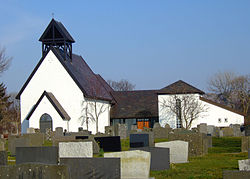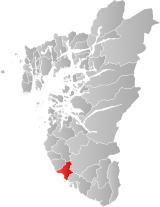Ogna (municipality)
Former municipality in Rogaland, Norway From Wikipedia, the free encyclopedia
Former municipality in Rogaland, Norway From Wikipedia, the free encyclopedia
Ogna is a former municipality in Rogaland county, Norway. The 104-square-kilometre (40 sq mi) municipality existed from 1839 until its dissolution in 1964. The municipality encompassed roughly the southern third of the present-day municipality of Hå. The administrative centre of the municipality was the village of Ogna where the Ogna Church is located.[3][4]
Ogna Municipality
Ogna herred | |
|---|---|
| Ogne herred (historic name) | |
 View of the local Ogna Church | |
 Rogaland within Norway | |
 Ogna within Rogaland | |
| Coordinates: 58°30′56″N 05°48′29″E | |
| Country | Norway |
| County | Rogaland |
| District | Jæren |
| Established | 1839 |
| • Preceded by | Eigersund Municipality |
| Disestablished | 1 Jan 1964 |
| • Succeeded by | Hå Municipality |
| Administrative centre | Ogna |
| Area (upon dissolution) | |
| • Total | 104 km2 (40 sq mi) |
| Population (1964) | |
| • Total | 1,470 |
| • Density | 14/km2 (37/sq mi) |
| Demonym | Ognabu[1] |
| Time zone | UTC+01:00 (CET) |
| • Summer (DST) | UTC+02:00 (CEST) |
| ISO 3166 code | NO-1117[2] |
The municipality of Ogna was established in 1839 when it was split off from the (much larger) municipality of Egersund landdistrikt, the rural municipality surrounding the town of Egersund. Initially, there were 825 residents of Ogna. During the 1960s, there were many major municipal changes across Norway due to the work of the Schei Committee. On 1 January 1964, the three neighboring municipalities of Nærbø, Varhaug, and Ogna were all merged into one large municipality called Hå. Prior to the merger, Ogna municipality had 1,470 residents.[5]
The municipality (originally the parish) is named after the old Ogna farm (Old Norse: Ógna) since the first Ogna Church was built there. The name comes from the verb ógna which means "to threaten", likely referring to the local river since it has strong currents and it is prone to flooding in the spring.[6] Historically, the name of the municipality was spelled Ogne. On 3 November 1917, a royal resolution changed the spelling of the name of the municipality to Ogna.[7]
While it existed, this municipality was responsible for primary education (through 10th grade), outpatient health services, senior citizen services, unemployment, social services, zoning, economic development, and municipal roads. During its existence, this municipality was governed by a municipal council of directly elected representatives. The mayor was indirectly elected by a vote of the municipal council.[8]
The municipal council (Herredsstyre) of Ogna was made up of 15 representatives that were elected to four year terms. The party breakdown of the final municipal council was as follows:
| Party name (in Norwegian) | Number of representatives | |
|---|---|---|
| Labour Party (Arbeiderpartiet) | 2 | |
| Christian Democratic Party (Kristelig Folkeparti) | 5 | |
| Local List(s) (Lokale lister) | 8 | |
| Total number of members: | 15 | |
| Party name (in Norwegian) | Number of representatives | |
|---|---|---|
| Labour Party (Arbeiderpartiet) | 2 | |
| Christian Democratic Party (Kristelig Folkeparti) | 4 | |
| Local List(s) (Lokale lister) | 9 | |
| Total number of members: | 15 | |
| Party name (in Norwegian) | Number of representatives | |
|---|---|---|
| Labour Party (Arbeiderpartiet) | 1 | |
| Christian Democratic Party (Kristelig Folkeparti) | 4 | |
| Joint List(s) of Non-Socialist Parties (Borgerlige Felleslister) | 3 | |
| Local List(s) (Lokale lister) | 4 | |
| Total number of members: | 12 | |
| Party name (in Norwegian) | Number of representatives | |
|---|---|---|
| Local List(s) (Lokale lister) | 12 | |
| Total number of members: | 12 | |
| Party name (in Norwegian) | Number of representatives | |
|---|---|---|
| Labour Party (Arbeiderpartiet) | 1 | |
| Christian Democratic Party (Kristelig Folkeparti) | 1 | |
| Local List(s) (Lokale lister) | 10 | |
| Total number of members: | 12 | |
| Party name (in Norwegian) | Number of representatives | |
|---|---|---|
| Local List(s) (Lokale lister) | 12 | |
| Total number of members: | 12 | |
| Note: Due to the German occupation of Norway during World War II, no elections were held for new municipal councils until after the war ended in 1945. | ||
Seamless Wikipedia browsing. On steroids.
Every time you click a link to Wikipedia, Wiktionary or Wikiquote in your browser's search results, it will show the modern Wikiwand interface.
Wikiwand extension is a five stars, simple, with minimum permission required to keep your browsing private, safe and transparent.